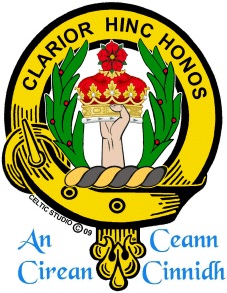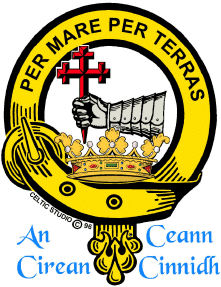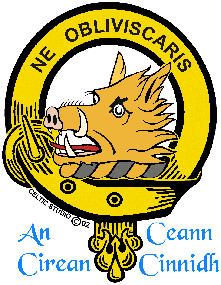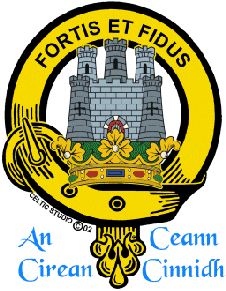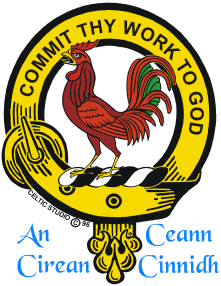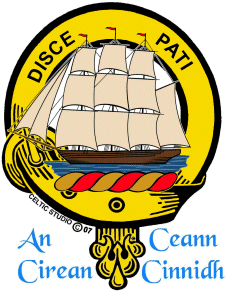SCOTTISH CLAN CRESTS .. HOW TO FIND THE CORRECT CREST!
There are approximately 300 Scottish Clan crests. These 300 Clan crests are associated with approximately 35,000 Scottish names. Some of these 35,000 names are spelling variations of the same name. In translation from Gaelic to English there are numerous different phonetic "attempts."There are an astonishing number of spelling variations in the spelling of Scottish family names! For example the name "Stirling" has over 65 variations in spelling. Quite astonishing! Part of the reason for such a large number of spelling variations is that surnames were still evolving, the translation of Scottish names from Gaelic to English and the ability to read and write was not wide spread.
A large number of the balance of these names are called "Septs". These fall into two major categories; connected to the major Clan through a warfare alliance for mutual protection or associated with the major clan through inter marriage. Indeed, the use of crest badges and tartan was so that members of the same Clan could recognize each other quickly and easily without the ability to read. The graphic image of the crest was an easy way for people who could not read to indentify another person of the same Clan. If they could read and write they would have used name tags with the Clan name on it. People are sometimes surprised that the crest does not have the Clan name written on the crest. This, of course, would have made the use of Clan crest unnecessary but the lack of the ability to read the written word was the reason Clan crests were created.
There are some "Sept" names that have more than one Clan connection. These Scottish names were connected to more than one Clan because they
created a number of alliances and/or intermarried with members of other Clans.
This can be rather confusing since those of the same Scottish family name can indeed choose between any of the Clan names and thus wear the crest or tartan of the Clan
alliance they have chosen. This is perfectly correct but confusing when different members of the same Scottish family choose different
Clan crests and associated tartans. In these
cases all of the Clan crests that represent
the different alliances are correct
One of the big issues with Scottish Clan
names is the use of the Clan crest versus the
Coat of Arms. Scottish heraldry is unique in
that there are strict laws in Scotland that
have been in place since 1673 when the Roll
of Scottish Arms was created. It is Scottish
heraldic law that only the
chief of the Clan can display a full Coat of
Arms. The definitive description is as
follows:
"Please note that the Coat of Arms properly
belongs to the Chief of the Clan. These are
not the "Family Arms"that can be
used by any person with the same Clan name.
They are the legal property of the Chief of
the Clan as recognised by Lord Lyon Master
of Bearings and Arms.
Such a thing as a general Coat of Arms for a
group of people with the same name does not exist in Scottish
heraldry. Arms are personal property and
represent ONLY the bearer. To wear or display
these arms would imply that you are Chief of
the Clan. Wearing or displaying someone
else's Arms in Scotland is a crime
punishable by arrest or fine. What is
proper to wear, as a clansman, is the crest
of your chief (the upper element on top of
the helm in the full achievement of the
Arms), surrounded by a belt and buckle
bearing your clan motto. This turns the
crest (a personal heraldic item) into a
badge (a communal heraldic item that
different people of the same Clan can wear or display to
denote their affiliation). The belt and buckle
design is the symbol that conveys this fact.
It is not your
personal crest but that you follow the
person who has been recognised by Lord Lyon
as the Chief and bears this crest as part of
his legally registered grant of Arms. In effect, you are not
Chief of the clan, but a loyal clansman.
Sometimes the battle cry is shown on the
belt and buckle instead of the motto, when a
clan has one."
SOME SAMPLES OF CORRECT CLAN CRESTS
The Gaelic inscription in blue at the bottom of the crest is required by "Lord Lyon" and means that "the crest shown is the crest of the Chief of the Clan."
| ||||||||||
From left to right: Buchanan, Mac Donald (Clan Donald), Campbell (Argyll), Mac Lachlan,
Below: Sinclair, Duncan
If anyone offers to sell you a Coat of Arms for your Scottish name they are indeed breaking Scottish heraldic laws. There are a number of Companies on the Internet that sell "Scottish Coat of Arms". These are incorrect and thus a waste of money since they are simply wrong. A number of these Companies have been sued. When I have contacted these Companies they seem to know that what they are selling is incorrect but persist anyway since it fits with their standard Coat of Arms designs on their web pages. These Coat of Arms are quite correct for ALL other nationalities but because Scottish heraldry is different. There is actually an existing Chief or owner of the Arms and it is his LEGAL property. For most Scottish names they are simply incorrect!
The exception to this rule is the case in which the Scottish family name is not connected to a Clan. Here it is found acceptable for those Scottish families to use the ancient Arms used for their name.
Scottish heraldic laws can not be enforced in North America, one of the reasons it is difficult to stop bogus sellers of "Scottish Coat of Arms", but if you show up in Scotland wearing a Coat of Arms that is not registered to you then you are indeed clearing displaying the fact that you have little knowledge of your Scottish heritage and Scottish heraldic laws. Don't worry, they will not fine or imprison you! They have lots of tourists who do not know the rules however you may be the polite subject of derision by those that know what is heraldically correct in Scotland. You will be displaying your lack of knowledge of both Scottish tradition and Scottish heraldic law. This is something that you probably don't want to do! Why waste your good money! In Scotland, they find it hilarious to see someone marching about in their newly purchased kilt displaying the Coat of Arms of the Chief when the wearer is DEFINITELY not the Chief of the Clan!
There is another group in Scotland called the "Standing Council of Scottish Chief's"who as a group of living Scottish Chief's try an ensure that Scottish heraldic law is complied to. These are real living people not some ancient historical characters that are long dead.
There is a second Scottish legal entity, "Lord Lyon Master of Bearings and Arms". This is a division of government and has been for hundreds of years. This body decrees who is and who is not entitled to display and wear a particular Coat of Arms. If there is a dispute as to who is the rightful Chief they decide on evidence presented to their Court. Quite frequently the Chief of the Clan can change, going from one branch to another based on the decision of "Lord Lyon". The new chief, once decreed by Lyon Court can decide to change the crest to his own preference since it is part of his/her personal Coat of Arms and to be correct, when the Chief changes his crest his followers should do so as well. This change does not make the previous Clan crest wrong it simply means that it is dated. When the new crest is decided and approved by "Lord Lyon" followers of the Clan should indeed update their use to the new crest on any new purchases. It is therefore valuable to deal with a supplier who is abreast of the most recent decisions of "Lord Lyon"since you will then be assured that you are using the most up to date and "authentic" crest for your current Clan Chief. Celtic Studio does this and attempts to be the most up to date site for correct Scottish Clan crest products. This is quite a task since it means that every master mold and design has to be re made for every product offered! Both expensive and time consuming but it is what must be done to offer the very best to the Scottish community worldwide.
In recent years the crest has changed for a number of Clans; Mac Innes, Mac Lennan, Lockhart, Murray, Russell and Fraser are just a few.
Hope this is of assistance in making sure you know that what you are purchasing is indeed correct.
For information on your Clan connection, a of picture of your colour Clan crest or what the current approved crest is you may contact Celtic Studio
Louis
